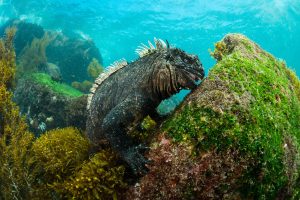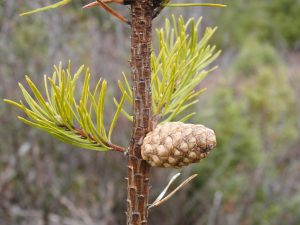8.2 Distribution of Life
The biosphere is the global sum of all ecosystems—it includes every region of Earth where life exists, from the deepest ocean trenches to the upper atmosphere. Many abiotic factors a crucial role in determining where life can exist and what types of organisms are found in different regions. The major abiotic factors include: energy source, temperature, water availability, and inorganic nutrients.
Energy Source
Most life on Earth ultimately depends on energy from the sun. This solar energy is captured by photosynthetic organisms (including green plants, algae, cyanobacteria, and some protists) which convert sunlight into chemical energy through photosynthesis. These organisms form the base of most food webs which supplies energy to all other living things, either directly or indirectly.
The availability of light is a key abiotic factor that influences where photosynthetic organisms can thrive. It also drives the evolution of specialized adaptations that help organisms capture and use light efficiently.
For example, in temperate forests, light availability changes dramatically with the seasons. In early spring, before the trees in the canopy fully leaf out, sunlight reaches the forest floor. This brief window of high light availability is critical for plants that grow, flower, and reproduce quickly before being shaded by the canopy above (spring ephemerals). One such plant is the spring beauty, which completes most of its life cycle in early spring. Its rapid growth and early blooming are adaptations to the seasonal pattern of light availability in the forest understory.

Figure https://inaturalist.ca/observations/208177782In aquatic ecosystems, light availability decreases with depth so photosynthesis is limited to the upper layers of water. This creates a vertical structure in aquatic food webs, with photosynthetic organisms concentrated near the surface and other organisms distributed according to their energy needs and feeding strategies.
Temperature
Temperature also plays a major role in determining where species can live. It affects the rate of biochemical reactions, the state and density of water, and the efficiency of metabolism. Most organisms can only survive within a relatively narrow temperature range. Temperatures below 0 °C can cause water in cells to freeze, damaging tissues, while temperatures above 45 °C can lead to enzyme breakdown and metabolic failure.
Because of these constraints, organisms must either regulate their internal temperature or live in environments that naturally support their physiological needs. Some species have evolved remarkable adaptations to cope with temperature extremes. For example, wood frogs can survive freezing temperatures by producing antifreeze-like chemicals that protect their cells.

Figure – https://inaturalist.ca/observations/13749729 (crop tighter?)
Water
Water is essential for all life on Earth. It plays a central role in cellular processes, including nutrient transport, chemical reactions, and temperature regulation. Because of its importance, the availability of water is a major factor influencing where organisms can live and how they function.
On land, terrestrial organisms constantly lose water to the environment through processes like evaporation and transpiration. To survive, they have evolved a variety of adaptations to conserve water. For example, many plants have waxy cuticles and leaf hairs that reduce water loss by slowing the rate of transpiration. These features are especially important in dry environments where water is scarce.
In aquatic environments, the challenge is not water loss, but maintaining internal solute balance. Freshwater organisms live in environments where water tends to enter their bodies by osmosis. To prevent their cells from swelling and bursting, they excrete dilute urine and actively regulate solute levels. In contrast, marine organisms are surrounded by salty water that draws water out of their bodies. These organisms have adaptations to retain water and excrete excess salts. For example the marine iguana (Amblyrhynchus cristatus) sneezes out salt-rich water vapor to maintain internal balance while feeding in the ocean.

Inorganic Nutrients
Inorganic nutrients, such as nitrogen, phosphorus, and potassium, are essential for the growth and survival of all living organisms. These nutrients are required for building proteins, nucleic acids, and other vital cellular components. The availability of these nutrients in the environment plays a major role in determining the distribution and abundance of life.
Plants absorb inorganic nutrients along with water from the soil. As a result, the structure, pH, and nutrient content of the soil are critical factors influencing where different plant species can grow. For example, sandy soils drain quickly and may lack nutrients, while clay-rich soils retain water and nutrients but may limit root penetration. Some plants are adapted to nutrient-poor soils, while others require rich, fertile conditions to thrive. For example, pitcher plants grow in nutrient-poor soils in bogs and wetlands. Because the soil lacks sufficient nitrogen and phosphorus, these plants have evolved a the ability to trap and digest insects to supplement their nutrient intake. This carnivorous strategy allows them to thrive in environments where most other plants would struggle to survive.

https://inaturalist.ca/observations/95181583
Animals, on the other hand, obtain inorganic nutrients by consuming plants or other animals. Therefore, their distribution is closely tied to the availability of their food sources. In some ecosystems, animals may migrate or shift their range in response to changes in the abundance or location of nutrient-rich food.
Other Abiotic Factors
There are many other abiotic factors that shape ecosystems.
In aquatic ecosystems, oxygen availability is a critical factor for survival. Unlike terrestrial animals that breathe air, aquatic organisms rely on dissolved oxygen in the water. The concentration of dissolved oxygen is influenced by water temperature and movement—cold, fast-moving water holds more oxygen than warm, still water. Other important abiotic factors in aquatic systems include salinity (salt concentration), currents, and tides, all of which affect the types of organisms that can live in different aquatic habitats.
On land, wind plays a significant role in shaping ecosystems. It can increase evaporation and transpiration rates which influences water availability for plants. Wind also acts as a physical force, moving soil, seeds, pollen, and even small organisms, thereby affecting patterns of plant growth and species dispersal. Another powerful terrestrial factor is fire. While often seen as destructive, fire is a natural disturbance that plays a vital role in many ecosystems. Some species are adapted to fire and even depend on it for reproduction. For example, the jack pine produces cones that only open and release seeds in response to the high heat of a fire. Fires can also recycle nutrients like nitrogen back into the soil and reduce competition by clearing dense undergrowth, allowing sunlight to reach the forest floor and promoting new growth.

Responding to Changing Abiotic Conditions
Abiotic factors such as temperature, light, and moisture are not constant. They can change seasonally, daily, or even suddenly due to weather events or natural disturbances like fires or floods. These fluctuations can significantly affect the survival and activity of organisms. To cope with these changes, organisms have evolved a variety of strategies that allow them to adjust to changing environments.
There are three main types of responses organisms use to adjust to changing abiotic conditions:
Physiological Responses
Physiological responses involve short-term or reversible changes in how an organism’s body functions. These changes help maintain homeostasis (the internal balance of body systems) even when external conditions shift.
When conditions are unfavorable, some animals enter a state of torpor where their metabolic rate drops significantly to conserve energy. Hibernation is a longer-term form of torpor used by some animals to survive cold winters when food is scarce. During hibernation, body temperature, heart rate, and breathing slow dramatically.
Another common physiological response is acclimation. Acclimation refers to gradual, reversible adjustments to a new environmental condition. For example, a fish moved from cooler to warmer water may gradually adjust its metabolism to function efficiently at the new temperature.
In humans, a notable physiological response occurs at high altitudes. When people travel or move to mountainous regions where oxygen levels are lower, their bodies respond by producing more red blood cells. This increases the blood’s oxygen-carrying capacity to help them function better in the thinner air.
Anatomical Responses
Anatomical responses are physical changes in an organism’s body structure that help it cope with environmental changes. For instance, animals in cold climates often grow thicker fur or develop fat layers for insulation during winter. This is also an example of acclimation because these anatomical changes reverse when the temperatures rise again.
Behavioral Responses
Behavioral responses are actions or movements that organisms perform to avoid or reduce exposure to unfavorable conditions. One of the most well-known behavioral responses is migration. Many animals migrate long distances to find more suitable climates, food sources, or breeding grounds. Humans also rely heavily on behavioral responses – we wear different clothing depending on the weather, use heating or air conditioning to regulate indoor temperatures, and modify our daily routines to avoid extreme conditions.
Knowledge Check
Type your exercises here.
- First
- Second

